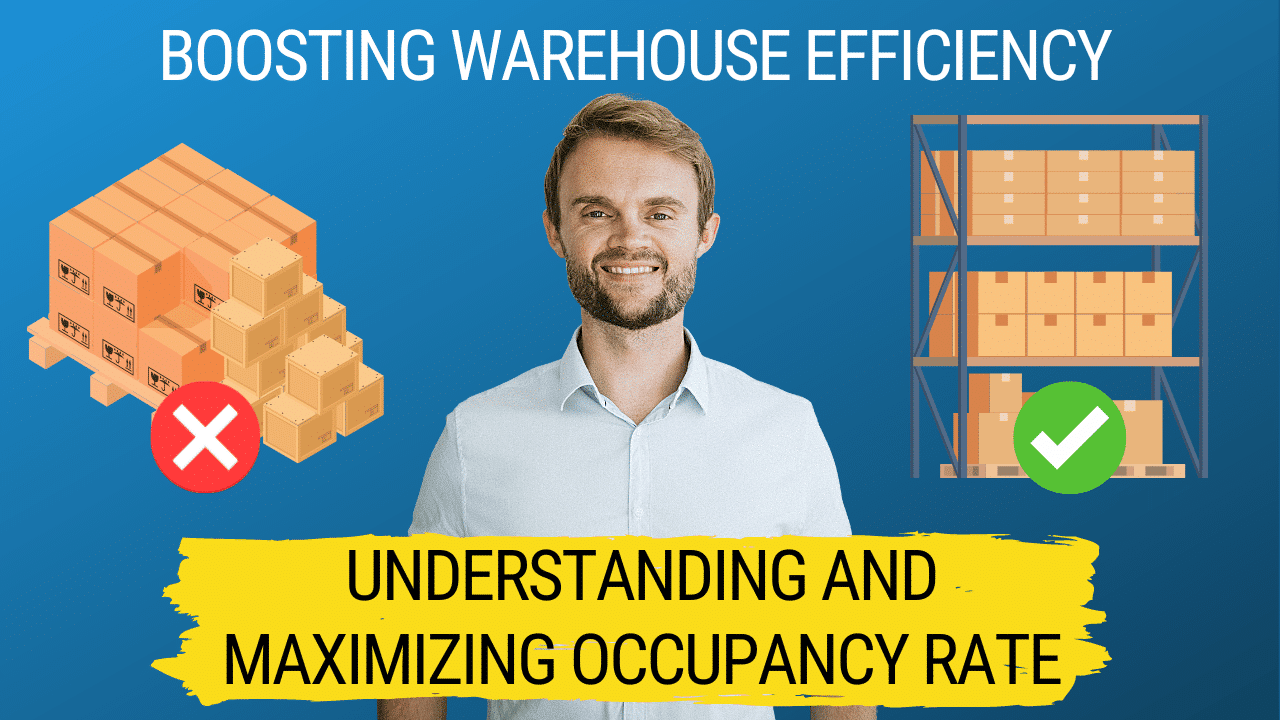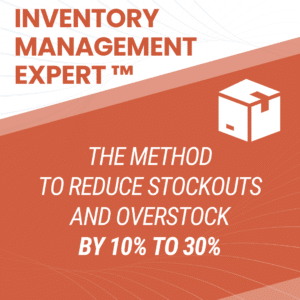We slightly touched on the subject in a previous publication: in the world of inventory management, achieving an optimal balance between inventory turnover and occupancy rate significantly contributes to operational efficiency and profitability.
In this article, we dive into the concept of warehouse occupancy rate, exploring its connection to inventory management and warehouse operations. I will provide examples and strategies for mastering these elements and optimizing both inventory turnover and occupancy rate.
Let’s also highlight the pivotal role of a warehouse manager in ensuring optimal operations and discuss the impact of key performance indicators (KPIs) in achieving a well-balanced and profitable warehouse operation.
Whether you’re a warehouse manager, a business owner seeking to enhance your warehouse operations, or someone interested in the warehousing world, I will tell you all I know about occupancy rates and all of the other factors that shape warehouse efficiency 💪.

What is the Warehouse Occupancy Rate?
The warehouse occupancy rate, a critical term in logistics and supply chain management, influences how effectively a company can handle its inventory and meet customer demands. This vital metric gauges the amount of space utilized in a warehouse compared to the total available storage area 📊.
It serves as a barometer of efficiency, enabling businesses to assess their warehousing operations’ effectiveness and identify areas for improvement.

Definition and Importance of Warehouse Occupancy Rate
In the simplest terms, the warehouse occupancy rate is the proportion of total warehouse space that is currently housing inventory. It is usually expressed as a percentage.
As a rule of thumb, a good average occupancy rate should be between 85% and 90%. To calculate your occupancy rate, simply apply this formula :
🧮 Occupancy Rate (OR) = Number of occupied location / Number of available location
Understanding and managing the warehouse occupancy rate cannot be overstated. It directly influences warehouse efficiency, overall operational costs, and the company’s bottom line. While seemingly productive, an extremely high occupancy rate can result in congested warehouse aisles, leading to inefficient operations, increased risk of accidents, and difficulty in maintaining inventory.

On the contrary, a very low occupancy rate might indicate the underutilization of space, suggesting that the business is incurring unnecessary costs for unneeded storage space.

For example, consider an online retail company with a warehouse occupancy rate above 90%. While this might initially appear to represent an effective use of space, it may lead to operational bottlenecks. The high occupancy rate could limit the worker’s ability to move goods efficiently, thereby affecting picking speed and delivery timelines.
Warehouse Occupancy Rate as a Key Performance Indicator
Regarding warehouse management, key performance indicators (KPIs) are vital tools to measure and track efficiency ⚙️. The warehouse occupancy rate stands as one such crucial KPI. Monitoring this metric provides invaluable insights into space utilization, allowing warehouse managers to make informed decisions about inventory levels, storage practices, and capacity planning.
➡️ Let’s take the example of a furniture manufacturing company that uses large warehouses to store raw materials and finished products. By keeping track of the occupancy rate, the warehouse manager can identify peak and off-peak seasons, thus strategizing inventory management accordingly 💭.
For instance, if the occupancy rate spikes during a certain period due to a seasonal increase in demand, they can prepare for it in advance by rearranging the warehouse layout or securing temporary additional storage.
When effectively managed and optimized, the warehouse occupancy rate is a KPI that can drastically enhance warehouse operations and directly contribute to a company’s profitability.
The Role of Inventory Management in Warehouse Occupancy
Inventory management, the systematic approach to sourcing, storing, and selling inventory, influences warehouse occupancy rates. Essentially, it is a juggling act between maintaining enough stock to meet demand and avoiding unnecessary overstock that could lead to high occupancy and increased costs.

Effective inventory management ensures an optimal balance, thus impacting warehouse occupancy rates positively. But how do they influence each other?
The Connection Between Inventory Management and Occupancy Rate
Inventory management and occupancy rate are interconnected aspects of warehouse operations. Efficient inventory management practices ensure the right amount of stock is available to meet demand and prevent overstocking, which can lead to increased warehouse occupancy.
Consider a grocery store chain that uses advanced inventory management systems. They ensure timely procurement, storage, and sale of perishable items, reducing the need for excess storage space and, thus, maintaining a moderate occupancy rate.
However, if the inventory management system fails or is inefficient, it might overstock perishable goods. This increases the occupancy rate and leads to losses due to expired products.

Balancing Inventory Turnover and Warehouse Occupancy Rate
Balancing inventory turnover and warehouse occupancy rate is a nuanced task requiring strategic planning and execution. Inventory turnover refers to the number of times inventory is sold or used in a given period. A high inventory turnover is usually favorable, indicating strong sales compared to inventory levels. However, it should be balanced with an optimal occupancy rate to ensure the warehouse operates efficiently.
For example, a popular fashion retailer might experience high inventory turnover due to great sales. The retailer might be tempted to overstock to keep up with the demand, leading to a high warehouse occupancy rate. High occupancy rates could :
disrupt warehouse operations ⚠️
cause delays in order delivery 🚚
and eventually, impact customer satisfaction 😡
Therefore, it is crucial to find a balance. I previously shared with you 11 ways to optimize your inventory which would directly impact your occupancy rate.
Balancing inventory turnover with warehouse occupancy rate can be challenging but vital for operational efficiency and profitability. Using intelligent inventory management systems, employing data analytics for forecasting, and implementing lean management practices are some ways to maintain this balance.

Mastering Warehouse Operations for Optimal Occupancy Rate
While inventory management is the backbone of maintaining an optimal occupancy rate, effective warehouse operations contribute equally to this goal. From proper layout planning to systematic inventory arrangement, efficient goods receipt, and prompt dispatch, every step in warehouse operations influences the occupancy rate.

Mastering these operations can help businesses strike the perfect balance, ensuring neither under-utilization nor over-utilization of warehouse space.
Understanding the Impact of Efficient Warehouse Operations on Occupancy Rate
Efficient warehouse operations translate into faster movement of goods, fewer bottlenecks, and better utilization of space, all of which positively impact the warehouse occupancy rate ↗️.
Take the case of a global e-commerce giant operating large-scale warehouses or fulfillment centers like Amazon. They ensure the swift movement of goods through efficient operations: automated sorting and dispatching, streamlined picking and packing processes, and advanced tracking systems. This leads to a high inventory turnover rate, avoiding overstocking and thus keeping the occupancy rate in check.
Traditional warehouses that lack such operational efficiency could have a lower inventory turnover. Due to operational delays, goods might remain stored longer, resulting in higher occupancy rates.
The Role of a Warehouse Manager in Ensuring Optimal Operations
The warehouse manager plays a pivotal role in ensuring operational efficiency and, by extension, managing the warehouse occupancy rate. They are responsible for strategic planning, coordinating warehouse operations, and making key decisions regarding inventory levels and storage.

Imagine a warehouse manager for a pharmaceutical company. In this case, the inventory includes various drugs and vaccines, each with its storage requirements and shelf life. It’s up to the warehouse manager to ensure optimal storage conditions for each product, manage stock levels to avoid overstocking or stockouts, and maintain stringent quality control. By doing so, they control the warehouse occupancy rate, preventing overcrowding that could jeopardize the stored pharmaceuticals’ integrity.
Moreover, the warehouse manager is crucial in implementing new technologies or systems that improve warehouse operations. For instance, they might oversee the integration of a Warehouse Management System (WMS) or automation technology, both of which can dramatically improve efficiency and help manage the warehouse occupancy rate more effectively.

Occupancy Rate & Inventory Turnover: how are they linked?
In essence, the occupancy rate refers to the percentage of total warehouse space that is currently housing inventory. In contrast, inventory turnover represents how often the inventory is sold or used up in a given period.
The relationship between these two can be viewed as an operational matrix, where the optimal warehouse operation sits at a point of balanced high inventory turnover and optimal occupancy rate.
➡️ For example, a tech gadgets retailer may experience high demand during holiday seasons, resulting in a high inventory turnover. They might be tempted to order more to meet the demand and avoid stockouts. However, once the holiday season ends, sales could slow down. The warehouse is left with high occupancy due to overstocking, leading to increased storage costs and inefficient operations.
Strategies to Optimize Both Inventory Turnover and Occupancy Rate
Successfully optimizing inventory turnover and occupancy rate requires a strategic approach leveraging effective inventory management, efficient warehouse operations, and intelligent forecasting. Here are 3 strategies to optimize both inventory turnover and occupancy rates:
One strategy could involve implementing just-in-time inventory management, which focuses on ordering and receiving goods only as they are needed in the production process, thus reducing the warehouse occupancy rate and improving inventory turnover.
Businesses could also implement demand forecasting to predict future sales patterns and inventory requirements. For instance, a clothes retailer may use historical sales data to forecast demand for different seasons, thereby adjusting their stock levels appropriately to ensure a high inventory turnover and maintain an optimal occupancy rate. I tell you all about forecasting in Excel in my article Forecasting in Excel in 3 clicks.
Warehouse layout optimization is another strategy that could help. By designing the warehouse to facilitate a smooth flow of goods and efficient picking and packing processes, businesses can improve their inventory turnover rate without significantly increasing the warehouse occupancy rate.
The relationship between occupancy rate and inventory turnover is complex, but with careful planning and strategic execution, businesses can optimize both. This approach will improve warehouse efficiency, better customer satisfaction, and ultimately, increase profitability. It’s a win-win-win situation 💪!
Leveraging Key Performance Indicators (KPIs) for Warehouse Management
Key Performance Indicators (KPIs) serve as valuable metrics to gauge the effectiveness and efficiency of warehouse operations, helping businesses identify areas for improvement and make strategic decisions.

Occupancy Rate as a Crucial Warehouse KPI
As we’ve discussed, the occupancy rate is a crucial KPI for any warehouse, representing the percentage of the warehouse capacity currently utilized. It’s a significant indicator of the efficiency of space utilization and inventory management.
A consistently high occupancy rate may imply efficient use of space but could also suggest overstocking, leading to inefficiencies in operations. Conversely, a low occupancy rate might indicate under-utilization of the warehouse space, resulting in unnecessary costs.
For example, an electronics warehouse with an occupancy rate consistently above 80% would need to consider whether its high occupancy rate is due to efficient space utilization or an overstocking issue.
If it’s the latter, they may need to revisit their inventory management strategies to reduce overstocking, thus lowering the occupancy rate to an optimal level.
Other Key KPIs in Warehouse Management and Their Interrelation with Occupancy Rate
Besides occupancy rate, several other KPIs are critical in warehouse management and often correlate with occupancy rate.
➡️ One such KPI is the Order Cycle Time, which measures the time taken from when an order is received until it’s shipped. If this KPI is high, it may suggest inefficient warehouse operations, potentially leading to a higher occupancy rate due to goods not being shipped in a timely manner.
For example, a book distributor with a high Order Cycle Time might also find their warehouse occupancy rate high. The delay in processing and shipping orders means more books remain in the warehouse for longer, increasing the occupancy rate.
➡️ Another key KPI is Inventory Accuracy, which assesses how accurately the physical inventory matches the inventory recorded in the system. Discrepancies can lead to overstocking or stockouts, both of which can impact the warehouse occupancy rate.
Consider a car parts manufacturer with low Inventory Accuracy. They may experience overstocking due to inaccurate recording of parts received or shipped, resulting in a higher occupancy rate. They might need to enhance their inventory tracking and recording systems to address this.

➡️ The Order Picking Accuracy KPI, which measures the percentage of orders picked correctly, also indirectly affects the occupancy rate. Inaccurate picking can delay order fulfillment and increase the occupancy rate.
Different KPIs offer significant insights into warehouse operations and are crucial for managing and optimizing the warehouse occupancy rate. By monitoring these indicators, your business can make data-driven decisions, enhance its warehouse operations, improve inventory management, and optimize its occupancy rate for better profitability.
Become an Inventory Management Expert
If you want to go to the next level, join my 7-day workshop (free): How to reduce stockouts and overstocks.
7 days of free advice to optimize your inventory from scratch:
👉 Gain visibility into your inventory and service levels.
👉 Simplify, automate your inventory management
👉 Improve your performance and regain control of your time.







